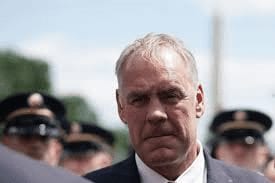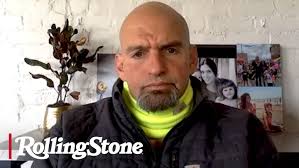he Case Against Ryan Zinke: With EPA chief Scott Pruitt gone, liberals are setting their sights on another Trump cabinet member whose scandals are mounting. – By Emily Atkin (newrepublic.com) / July 30 2018
 Alex Wong/Getty Images
Alex Wong/Getty Images
On March 2, 2017, Ryan Zinke hoisted himself atop a horse named Tonto, and rode “triumphantly” into his first day of work in charge of America’s public lands. At least that’s how Benny Johnson, then a writer for the conservative news site Independent Journal Review, described it. “The cowboy hat is now in charge,” he wrote.
Two weeks later, the same reporter accompanied Zinke as he toured downtown D.C. on a snow day. The resulting 2,500-word article saw the new secretary of the Department of the Interoir personally shoveling snow from the Lincoln Memorial steps, chatting up tourists, and promising never to close off monuments during a government shutdown like President Barack Obama once did. In his articles for IJR, Johnson often painted the former Navy SEAL as an irresistible figure—a patriot with respect for authority; a tough guy who carries an “ISIS Hunting License”; a kind-hearted soul who loves puppies. Zinke, as Johnson wrote, was an “all-around badass.”
Sixteen months in, Zinke’s cowboy image has been dented. He’s worn both a park ranger hat and a cowboy hat backwards. He botched a fishing rod while being profiled by Outside Magazine. He’s been criticized by Teddy Roosevelt’s grandson—twice.
But more significantly, the self-proclaimed “Teddy Roosevelt guy” has been quietly dismantling environmental protections for cherished public lands, repeatedly yielding to oil industry interests and big-game trophy hunters, and leading the administration’s charge against protecting endangered species. He’s also been the subject of nearly a dozen federal investigations, which include allegations of taxpayer waste (like ordering $139,000 doors for his office) and ethics violations (like flying on a private plane owned by oil and gas executives).
Zinke is increasingly vulnerable. The latest polling, from March, shows he has the lowest approval rating of all of the Trump administration’s cabinet members. He’s even gotten on the president’s bad side. Now, after Scott Pruitt’s resignation as head the EPA last month, environmental groups have marked Zinke as their next top target—and the last month has given them plenty of ammunition.
Perhaps Zinke’s most controversial move came earlier this month, with the proposed dismantling of the Endangered Species Act. On July 19, the Department of the Interior announced major changes to the 45-year-old law that, according to The New York Times, “could have far-reaching implications” for threatened and endangered animals. The changes would quicken the approval process for projects like oil and gas drilling, coal mining, and road-building in places like the Arctic National Wildlife Refuge.
This move was very much the work of Zinke. As the Times editorial board noted last week, the ESA proposal was “announced by David Bernhardt, the deputy secretary of the Interior Department and one of several spear carriers for the oil and gas industry who have risen to commanding policymaking roles under [Zinke].”
As Mark Binelli wrote in an expansive Rolling Stone profile published last week, “there’s been a consistent swampiness to Zinke’s political appointees.” In addition to Bernhardt, “one of the department’s top lawyers, Daniel Jorjani, previously served as an adviser to Charles Koch; Todd Wynn, the DOI’s director of Intergovernmental and External Affairs, worked for Koch Industries-backed think tanks and power-industry trade organization the Edison Electric Institute.” Zinke also appointed 15 outdoor industry representatives to advise him on how to manage public lands this past March. According to The Washington Post, this “marks the third time the secretary has assembled panels dominated by industry players to help chart policies affecting their businesses.”
Industry has thus had a hand in all of Zinke’s most high-profile decisions: the downsizing of national monuments, the expansion of offshore oil drilling, the weakening of the Migratory Bird Treaty Act—not to mention the undoing of regulations on fracking, coal mining, methane emissions, and offshore drilling safety. It’s therefore likely the fossil fuel industry played a part in the Interior’s most recent regulatory decision: to eliminate the requirement that drillers and miners pay for damage they’ve caused to public lands during development.
Last week, the Interior’s Bureau of Land Management published a memorandum seeking to mostly eliminate “compensatory mitigation,” the practice that energy companies must pay the federal government for restoring damaged land or buy new land to set aside for conservation. In a secretly recorded June speech, Zinke suggested the long-standing practice amounted to “extortion”—which The National Wildlife Federation’s Tracy Stone-Manning called “over-the-top” rhetoric. “It’s not extortion,” she told the Post. “It’s the cost of doing business on our public lands.” As Outside noted, “policies like this were actually designed to help the environmentalist and pro-extraction camps work through arguments.”
But Zinke seems uninterested in preserving compromises between conservation interests and fossil fuel interests. He also seems uninterested in letting facts compromise his decision-making on behalf of those interests. For example, before he decided to significantly reduce the size of two of Utah’s largest national monuments—Bears Ears and Grand Staircase-Escalante—the Interior was given hard evidence that the sites “boosted tourism and spurred archaeological discoveries,” according to a Post report last week. But officials did not include that evidence in its assessment, for the explicit purpose that it would undercut their argument. (This was discovered due to a batch of internal emails the Interior inadvertently released to reporters).
Most policy changes under Zinke can be easily undone by future administrations. But according to Binelli’s recent Rolling Stone profile, Zinke’s ultimate goal may be much more difficult to change. “Ultimately, Zinke plans to enact the largest restructuring of the DOI in its history,” he wrote. This would be done by “moving thousands of workers, and the headquarters of entire bureaus, from Washington to regional locations—and in the process, disrupting the power and access of a bureaucracy in which a third of its career employees have been deemed to have failed a loyalty test.”
This lofty goal may match Zinke’s political ambitions. As Binelli and many others have reported, speculation has swirled for months that Zinke is interested in a higher office one day—perhaps even the presidency. If this sounds familiar, it’s probably because Pruitt, the EPA’s former chief, had similar ambitions. But Pruitt was ultimately undone, thanks in part to environmental groups who helped to expose his ethics scandals. Zinke, in other words, won’t be their first rodeo.
https://newrepublic.com/article/150255/case-ryan-zinke



















